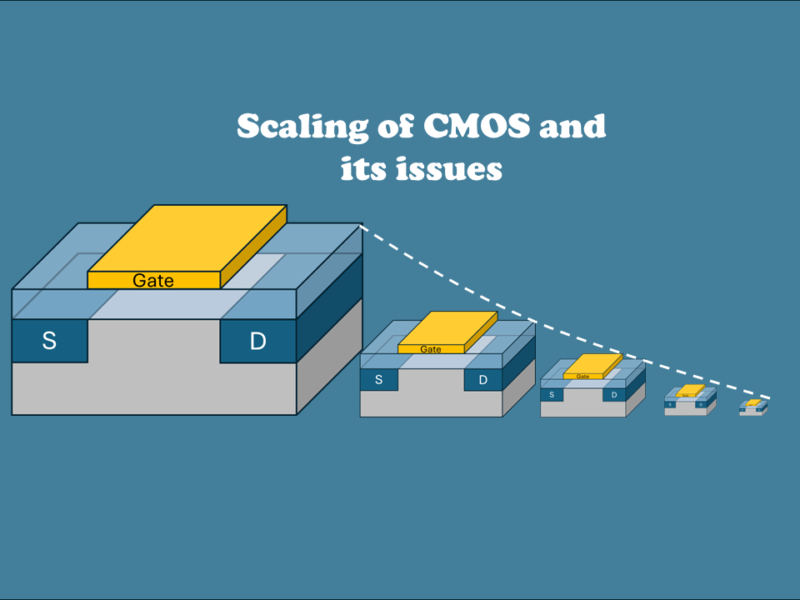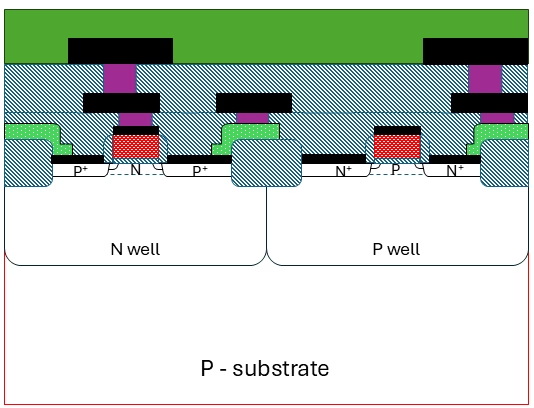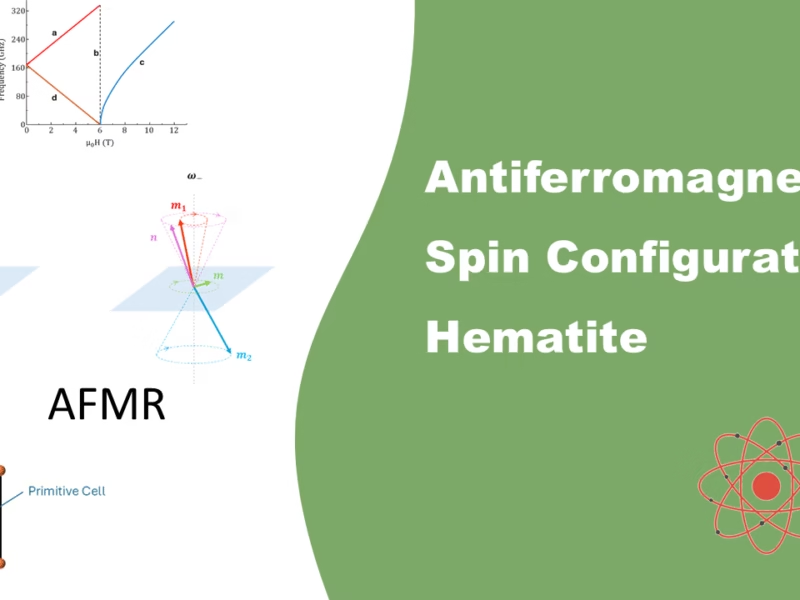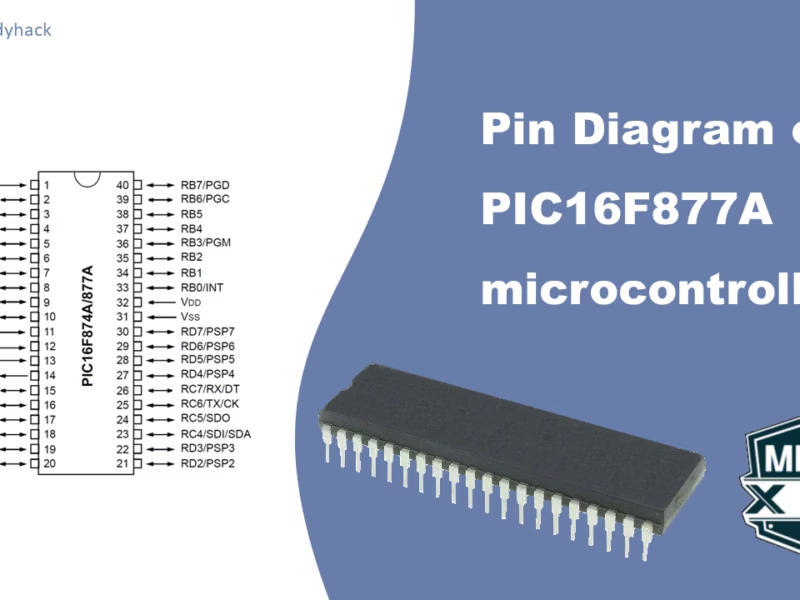1. Electronic Band Structure in Materials
Materials can be classified as metals, semiconductors, or insulators based on their electronic band structure. Metals have either partially filled valence bands or overlapping valence and conduction bands, allowing free electron movement and high electrical conductivity. Insulators, in contrast, have a completely filled valence band and a large band gap, making it difficult for electrons to gain enough energy to move into the conduction band and contribute to electrical current.
Semiconductors occupy an intermediate position between these two extremes. As more atoms come together to form a solid, their discrete atomic energy levels broaden into continuous energy bands due to orbital overlap. The key contributors to these bands in semiconductors are the s- and p-states of the atoms. At a critical atomic spacing, these states mix and split into two distinct energy bands: the valence band and the conduction band.
Each band consists of one s-state and three p-states, where each state can accommodate two electrons (one spin-up, one spin-down). This results in a total of eight energy levels, four forming the valence band and four forming the conduction band.
In Group IV materials (e.g., Carbon, Silicon, and Germanium), each atom has four valence electrons, which completely fill the valence band at low temperatures, leaving the conduction band empty. This creates a band gap, an energy range with no allowed electronic states, which electrons must overcome to transition from the valence to the conduction band and contribute to conduction.
The size of this band gap determines the material’s electrical properties and decreases with increasing atomic number: Carbon (5.48 eV), Silicon (1.17 eV), and Germanium (0.67 eV). This variation explains why the last two materials behave as semiconductors rather than insulators or conductors. Especially Silicon, j
2. Intrinsic Semiconductors: Properties & Excitation Mechanisms
An intrinsic semiconductor is a pure semiconductor, i.e. without any host impurities in its crystal lattice. This means it is 100% Si. When the temperature T = 0K, the material behaves like an insulator, because its valence band is filled by electrons, and its conduction band is empty and nothing can move. Things became more interesting when you excite carriers across the gap, into the conduction band.
In order for an intrinsic semiconductor to become conducting, electrons have to be excited to the conduction band, where they can be accelerated by an external electric field. Likewise, the electron holes which are left behind in the valence band contribute to the conduction. However, these migrate in the opposite direction to the electrons. As a side note, a hole is not a physical particle, it just gives an easy description, as it can be thought of the same as a vacant electron state. Holes will however move in the opposite direction of an electron. This results from the calculation of the effective mass, which is negative for holes, and positive for electrons. The sign of the effective mass is determined directly from the sign of the curvature of the E-k curve:
\[ m^* = \frac{2}{d^2E/dk^2}\]
There are different mechanisms to excite an electron from the top of the valence band (VB) to the bottom of the conduction band (CB); thermal energy, electrical field, electromagnetic energy:
Thermal energy
\[\text{Thermal energy} = k\times T = 1.38\times 10^{-23} J/K\times 300 K=25 meV\]
\[\text{Excitation rate = constant}\times \text{exp}(E_g/kT)\]
With a thermal energy of 25 meV at room temperature, it is not sufficient. However, with quantum mechanics, its about probability; and with enough electrons, there is a possibility that some do make the jump. Despite the fact that the termal energy is very small, the excitation rate is very high. That is why this is still an important way for the electrons to jump to the conduction band.
Electrical field
To obtain energy in the order of 1 eV, you require an electric field of 1018 V/m, which is huge. Therefore, for most low fields, this mechanism does not provide sufficient energy to make semiconductors like Si, or GaAs conductive.
Electromagnetic radiation
\[E=h\nu = h\frac{c}{\lambda} = \frac{6.62\times 10^{-34} Js \times 3\times 10^8 m/s}{\lambda}\]
\[E (eV) = \frac{1.24}{\lambda (\mu m)}\]
where 1 eV = 1.6 × 10-19 J. For silicon with a bandgap Eg ≈ 1.1 eV:
\[\lambda = \frac{1.24}{1.1} = 1.1 \mu m\]
To excite electrons to the conduction band in silicon, the wavelength of the photons must be 1.1 μm or less.
3. Charge Carriers & Conductivity in Semiconductors
To understand the behavior of a semiconducting material, one must consider thermal energy. The operating temperature range of a semiconductor can be determined based on its electronic properties. This section explores these concepts.
When an electron transitions from the valence band to the conduction band, it leaves behind a hole. In an intrinsic semiconductor, the number of electrons and holes is equal. The probability of such a transition occurring is governed by the Fermi-Dirac (FD) distribution:
\[f(E)=\frac{1}{\text{exp}\left[(E-\mu)/k_BT\right]+1}\]
where μ is the chemical potential (equal to the Fermi energy EF at T = 0). kB is the boltzmann constant.

In metals, the Fermi level represents the highest occupied energy level at absolute zero. However, this definition does not apply to semiconductors, where the Fermi level instead corresponds to a probability distribution. At T = 0, the Fermi-Dirac (FD) distribution forms a step function. As temperature increases, the distribution’s tail extends further into the conduction and valence bands, increasing the number of electrons in the conduction band (CB) and holes in the valence band (VB).
Regardless of temperature, the Fermi energy is defined as the energy at which the FD distribution function equals 1/2. In an intrinsic semiconductor, this places the Fermi energy at the midpoint of the band gap:
\[E_F = \frac{E_g}{2}\]
3.1 Number of electrons
The carrier density, i.e. the number of electrons, and the number of holes that you have don’t just depend on the Fermi-Dirac distribution, but also depends of the number of states that you have. It can be calculated by the following expression:
\[ n=\int_{E_g}^\infty Z(E)f(E)dE\]
where Z(E) is the density of states, i.e. the number of energy states per energy level in the conduction band, and f(E) is the FD distribution as described above, but with EF instead of μ.

To calculate the carrier density of intrinsic semiconductors, we need to go through several mathematical equations. We start with the Fermi energy, which is related to the density of electrons (N/V) through the expression:
\[E_F = \frac{\hbar^2}{2m}\left(\frac{3\pi^2N}{V}\right)^{2/3}\]
The total number of orbitals as a function of energy, for E < EF is given by the general expression:
\[N =\frac{V}{3\pi^2}\left(\frac{2m^*_eE}{\hbar^2}\right)^{3/2}\]
The density of states becomes:
\[Z(E)=\frac{dN}{dE}=\frac{V}{2\pi^2}\left(\frac{2m^*_e}{\hbar^2}\right)^{3/2}(E-E_G)^{1/2}\]
Approximating the Fermi-Dirac distribution by the Maxwell-Boltzmann (MB) distribution, which is valid at moderate T and for concentrations lower than 1015 /cm3:
\[f_{MB}(E)=\text{exp}\left(\frac{-(E-E_F)}{k_BT}\right)\]
results in
\[n=C\int_{E_G}^\infty (E-E_G)^{1/2}\text{exp}\left(\frac{-(E-E_F)}{k_BT}\right)dE\]
the concentration of electrons (n) than reads:
\[\begin{aligned}
n & =\ 2\left(\frac{2\pi m^*_e k_BT}{h^2}\right)\text{exp}\left(-\frac{E-E_F}{k_BT}\right)\\
& = N_c\text{exp}\left(-\frac{E-E_F}{k_BT}\right)
\end{aligned}\]
and the concentration for holes:
\[\begin{aligned}
p & =\ 2\left(\frac{2\pi m^*_h k_BT}{h^2}\right)\text{exp}\left(\frac{-E_F}{k_BT}\right)\\
& = N_v\text{exp}\left(\frac{-E_F}{k_BT}\right)
\end{aligned}\]
where Nc and Nv are the effective density of states in the conduction band and valence band, respectively. In both cases, the first term can be grouped into an effective density of states for the conduction band for electrons and for the valence band for holes.
As I’ve mentioned before, the number of holes and electrons in an intrinsic semiconductor are the same, n = p, and we can express this by talking about the intrinsic carrier density. These are carriers which are intrinsically available in the material, and which are different from the ones that are induced by doping. The intrinsic carrier concentration, ni, is given by the expression:
\[\begin{aligned}
n_i & =\ \sqrt{np}=\frac{2(2\pi)^{3/2}(m^*_e m^*_h)^{3/4}}{h^3}(k_BT)^{3/2}e^{-E_g/2k_BT}\\
& = \sqrt{N_cN_v}e^{-E_g/2k_BT}
\end{aligned}\]
Examining the last term of this equation, we see a strong resemblance to the Arrhenius equation, where the activation energy corresponds to Eg/2 . This implies that the process is highly temperature-dependent: at low temperatures, only a few carriers have enough energy to overcome the barrier, resulting in a low carrier concentration. However, at higher temperatures, more carriers gain sufficient energy, significantly increasing ni. From an engineering point of view, when you don’t want your semiconductor to have intrinsic carriers, you may want to shift to materials with larger bandgap. This is because you do not want your semiconductor devices to be dominated by intrinsic carriers. This is because, when making n- and p-type transistors for example, the intrinsic carriers will completely ruin this and make them not function anymore.
By equating n and p, one also obtains the position of the EF within the band-gap:
\[E_F = \frac{E_g}{2}+\frac{3}{4}k_BT\text{ln}\left(\frac{m_h^*}{m_e^*}\right)\]
The Fermi level in a pure semiconductor lies close to the midgap. If the effective mass of the two would be the same, then EF would be exactly in the middle.
3.2 Conductivity versus Temperature
Due to the intrinsic carrier density, semiconductors exhibit a fundamentally different conductivity behavior compared to metals. In metals, electrical conductivity decreases with increasing temperature because higher temperatures lead to increased lattice vibrations (phonons), which scatter conduction electrons more frequently, reducing mobility.
In contrast, for intrinsic semiconductors, conductivity increases with temperature. This is because, as temperature rises, more electrons gain enough energy to transition from the valence band to the conduction band, increasing the number of charge carriers. Since conductivity depends on both carrier concentration and mobility , and the rapid increase in n dominates over the slight decrease in mobility due to phonon scattering, the net effect is a rise in conductivity.
Florius
Hi, welcome to my website. I am writing about my previous studies, work & research related topics and other interests. I hope you enjoy reading it and that you learned something new.
More Posts









